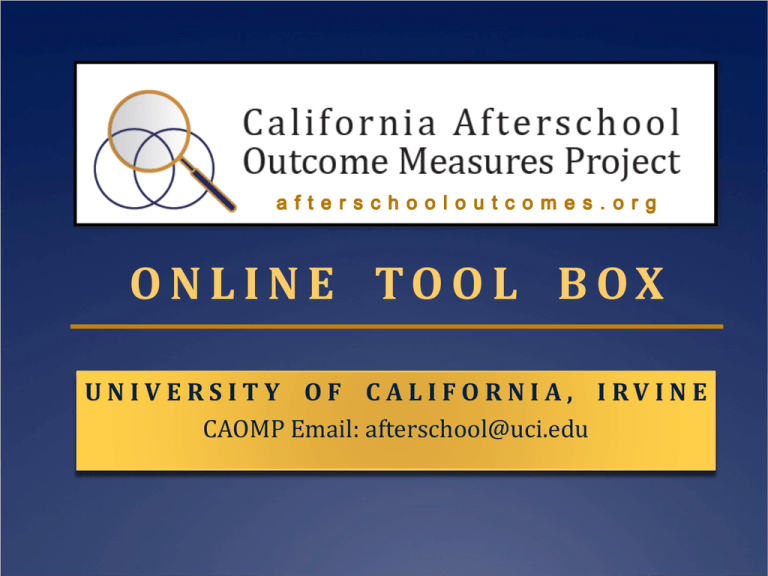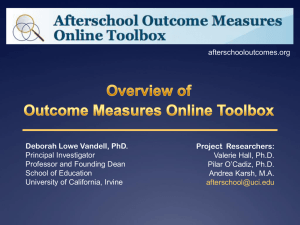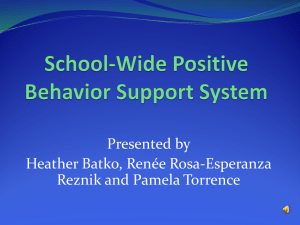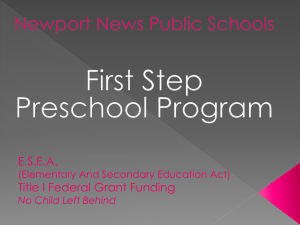California Afterschool Outcome Measures Project
advertisement

ONLINE TOOL BOX UNIVERSITY OF CALIFORNIA, IRVINE CAOMP Email: afterschool@uci.edu Background and Rationale for Online Toolbox Research indicates high quality afterschool programs can have beneficial effects on students both socially and academically The California Outcome Measures Project (CAOMP) developed an Online Toolbox in response to the State’s legislative mandate for alternative accountability measures to standardized test scores for publically funded afterschool programs* Toolbox includes reliable and valid measures of Positive Behavior Change and Skill Development to be used by State funded programs as part of their accountability measures Field Test of measures administered using online toolbox at over 200 afterschool and summer learning program sites concluded in Fall 2011 Online Toolbox will be made available for general use in Fall 2012 *In partnership with UC Davis and with support David and Lucile Packard Foundation & California Department of Education OVERVIEW Afterschool Outcome Measures Online Toolbox Web-based surveys of student performance collected from three respondents: 1. Students (grades 3-8) 2. Program staff 3. Classroom teachers PRE and POST Surveys collected at TWO time points, for example: Early Fall & Late Spring Beginning of Summer & End of Summer Technical Assistance provided through: Online Instructions and Resources Email and Telephone Communication Programs receive reports of their survey results at program and site level and aggregate results of California statewide data for comparison DESCRIPTION OF MEASURES Programs have option to administer one, two or all three surveys: (1) Student (grades 3-8; (2) Program Staff; and/or (3) Classroom Teachers STUDENT SELF-REPORTS —Elementary & Middle (5-6 subscales) Skill Development Work Habits Reading Efficacy Math Efficacy Task Persistence (middle school only) Positive Behavior Change Social Competencies Misconduct Program Quality (spring only) Staff & Activities Peer Affiliation PROGRAM STAFF & CLASSROOM TEACHER REPORTS —of Elementary & Middle School Student Performance (5-6 subscales) Skill Development Work Habits Task Persistence Academic Performance (classroom teachers only) Positive Behavior Change Aggressive Behavior with Peers Prosocial Behavior with Peers Social Skills SIGNIFICANT FINDINGS From 2010-11 Field Test PRE-POST OUTCOMES in MATCHED SAMPLE Staff Reports of Elementary Students Increase in Prosocial Behavior ** Staff Reports of Middle School Students Increase in Prosocial Behavior ** Teacher Reports of Elementary Students Increase in Academic Performance ** Decrease in Aggressive Behavior** Student Reports of Quality Program Experience Positive student reports of program experience linked to positive results in ALL student outcomes ** p<.01 * p<.05 SIGNIFICANT FINDINGS Staff Reports on Student Prosocial Behavior Increase in pre-post scores—matched sample Elementary School Students Middle School Students 1.4 1.43 1.39 1.42 1.42 1.38 1.41 1.36 1.4 1.34 1.39 1.32 1.38 1.3 1.37 1.28 1.37 1.36 1.26 1.35 1.24 1.34 1.28 1.22 Fall Spring Fall Spring SIGNIFICANT FINDINGS Teacher Reports on Elementary Students Academic Performance Increase in pre-post scores— matched sample 3.2 Aggressive Behavior Decrease in pre-post scores— matched sample 0.4 3.13 0.35 3.1 0.35 3 0.3 0.28 2.9 2.8 0.25 0.2 2.79 2.7 0.15 2.6 0.1 Fall Spring Fall Spring Program Quality Distribution Peer Affiliation Staff & Activities 45.0% 45.0% 39.3% 40.0% 34.3% 35.0% 39.7% 40.0% 34.3% 35.0% 32.6% 31.9% 30.0% 30.1% 30.0% 27.4% 25.9% 25.0% 18.9% 15.0% 10.0% 24.8% 25.0% 20.0% 32.8% 20.0% 15.0% 9.9% 10.0% 5.5% 5.0% 7.1% 5.4% 5.0% 0.0% 0.0% Low Fair Elementary Good Middle Excellent Low Fair Elementary Good Middle Excellent Quality to Outcomes Student reports of higher quality experiences with staff & activities are linked to greater Math Efficacy 3.8 Student reports of higher quality experiences with peers are linked to less Aggressive Behavior 0.70 3.63 3.6 3.49 0.64 3.47 0.60 0.60 3.4 3.2 0.53 3.20 3.13 0.50 0.45 0.43 3 0.40 2.8 2.73 0.34 2.6 0.30 2.4 0.20 2.2 2 0.10 Low Quality Mid Quality Elementary Middle High Quality Low Quality Mid Quality Elementary Middle High Quality How does it work? EASY TO ADMINISTER Step-by-Step Instructions Available to download from CAOMP Website afterschooloutcomes .org Updated Website to Launch JANUARY 2012 Online Toolkit Available to public FALL 2012 GO TO PROJECT WEBSITE: afterschooloutcomes.org 1. Click on “Field Test Surveys” tab at top. 2. SELECT appropriate survey: Once survey link is selected you should see this first page of the survey. Example: Elementary Student Survey 3. Student a. Selects language [English or Spanish] b. Enters assigned survey code: Click down For Spanish 4. When student finishes survey—in about 10 minutes—this final page should appear. Program Staff & Teacher Surveys Reports on Students in Afterschool Program Program Staff and Classroom teachers are assigned individual access codes Use both individual access code and the ID code for each student for whom they complete a report Each student report takes 3-5 minutes to complete. Student reports may be completed in multiple sessions. For example: A staff completing reports for 20 students can do four reports a day (a 20-minute session) on five different days. Expands accountability tools beyond standardized test scores and other academic measures Provides a battery of valid, reliable and easy to administer youth outcome measures • Currently include: Skill Development, Positive Behavior Change & Program Experience • Process of testing measures of STEM (Science, Technology, Engineering and Math) learning in afterschool • Aim is to make available a menu of measures that match a range of student outcome goals for diverse out-of-school time programs Value in tracking individual student performance over time with matched pre-post surveys—providing more powerful & interpretable data • Matched = Respondent data is matched for both pre and post survey administrations (i.e. same students, staff and/or teachers in fall and spring) Information can be useful to to guide program improvement based on student reports of program experience AND on student performance











